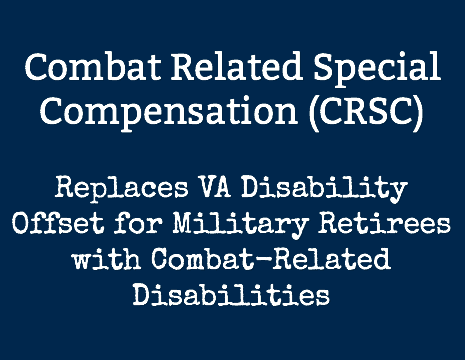Did you know that if you are a military retiree with a combat-related disability you may be eligible to receive additional compensation through the Combat Related Special Compensation (CRSC) program? This is a relatively new law that many retirees are not aware of.
Until 2004, there was a law on the books that prevented military retirees from receiving both military retirement pay and VA service-connected disability compensation simultaneously. Military retirees could choose to receive VA disability compensation if they were eligible. Still, their military retirement pay would be offset by the exact amount of compensation they received from the VA. The veteran received the same total compensation as their full retirement pay. However, the spending power was greater because VA disability compensation is tax-exempt.
In 2004, a law called Concurrent Retirement Disability Pay (CRDP) was passed. CRDP allows military retirees to receive both military retirement pay and VA disability compensation if they held a VA disability rating of 50% or greater. This is a substantial increase in compensation for these veterans who are eligible to receive their full military retirement pay and their full VA disability compensation.
But retirees with less than a 50% disability rating were left in the dark regarding receiving greater compensation. While lawmakers didn’t extend the concurrent receipt laws to cover all disability ratings, they did create a similar law for veterans with a “combat related” disability, even if they do not have an overall disability rating of 50%.
In 2008, Congress passed a law called the Combat-Related Special Compensation (CRSC) (10 U.S. Code § 1413a), which allows military retirees to receive monthly compensation to replace some or all of their VA disability offset if they have a combat-related injury. Let’s take a deeper look at CRSC, what it is, who it affects, and how to apply for this benefit.
Table of Contents
What Is Combat Related Special Compensation?
Combat-Related Special Compensation was created to replace the VA disability offset for service-connected disabilities that are a direct result of combat related injuries, to include injuries that occur during combat or armed conflict, or during combat training, training that simulates war, while performing hazardous duty, or from exposure to an instrumentality of war (such as military combat vehicles, agent orange exposure, etc.).
Combat-Related Special Compensation compensates eligible military retirees that will replace some or all of the VA disability offset. Their military retirement pay will no longer be deducted by the amount of their VA disability compensation. Instead, they will receive their full military retirement pay, and a CRSC payment based on the percentage of their disability rating that is considered combat-related.
It’s important to note that CRSC payments only apply to disabilities that are considered combat related. So it is possible that your CRSC payment can be less than your overall VA disability rating and, thus, less than your VA disability offset. Like VA Disability compensation, CRSC payments are tax-free.
Combat Related Special Compensation Eligibility
Here are the eligibility requirements, according to DFAS — To qualify for CRSC:
- You must be entitled to and/or receiving military retired pay (Active or Reserve with 20 years or creditable service; Chapter 61 medically retired with less than 20 years of service; Retired under Temporary Early Retirement Act (TERA); or retired under the Temporary Disabled Retirement List (TDRL)).
- You must have a VA service-connected disability rating of at least 10 percent
- Your military retirement pay is currently being reduced by your VA disability compensation (VA disability offset)
- You must file a CRSC application with your Branch of Service
Disabilities that may be considered combat related include injuries incurred as a direct result of:
- Armed Conflict / Combat: This can include direct or indirect wounds which occurred during armed conflict.
- Hazardous Duty: This can include activities such as demolition duty, diving, parachuting, aerial flight, and more.
- An Instrumentality of War: An instrumentality of war is a device such as a weapon or weapon systems specifically designed for military duty or warfare. This can include certain military combat vehicles, vessels, aircraft, or an injury or sickness caused by exposure to fumes, gases, or chemicals. Agent Orange exposure would qualify as an instrumentality of war.
- Simulated War: This can include activities such as military training, exercises, airborne ops, live fire exercises, hand-to-hand combat training, and more. This does not include standard physical training such as running, jogging, or group sports activities.
Eligibility Based on Service Dates and Back Pay: Anyone can be eligible to receive benefits under CRSC as long as they meet the eligibility requirements. This means it can apply to veterans who retired decades ago, or as recently as a month ago. There is even the possibility of receiving back pay if you are determined to be eligible for this benefit. However, if you retired with full longevity (20 or more years of service), you can only receive back pay as early as June 1, 2003, which was the effective date authorized by Congress. If you were medically retired under Chapter 61 with less than 20 years of service, back pay can only go back to January 2008, which was the effective date for authorizing veterans who retired with a medical retirement.
How to Apply for CRSC Benefits
Combat-Related Special Compensation is not automatic
You will need to apply for these benefits with your respective branch of service. They will assess your claim and determine your eligibility. To apply, you must fill out DD form 2860, along with the required documentation mentioned below, and send it to your respective military branch.
CRSC can be a complicated benefit because each case is unique. As always, it would be a good idea to consider using a Veterans Service Officer to help you with your benefits claims. They are often well-versed in applying for military and veterans benefits, and usually offer free assistance to veterans.
Documentation of Combat-Related Injury is Required
You must be able to show a causal link between your service-connected disability rating and a combat-related event. You will need to provide documentation of your military service, including your Form DD-214 or Form DD-215, military medical records pertaining to your injuries, military personnel files, line of duty determinations, safety mishap (accident) reports, military personnel data system printouts, prior military disability board decisions, casualty reports, official orders or travel vouchers, VA summary letters, or other official documents that can substantiate your claims.
Here is the important thing to remember: your records must clearly show your injury is combat-related.
Here is the contact info for submitting your CRSC claim:
Air Force
CRSC Program Office
HQ AFPC/DPSDC
550 C Street West, Suite 6
Randolph AFB
TX 78150-4708
Phone: 1-800-525-0102
Website: https://www.myairforcebenefits.us.af.mil/Help/Contact-Us
Army
Department of the Army
U.S. Army Human Resources Command
ATTN: AHRC-PDP-C (CRSC), Dept 480
1600 Spearhead Division Ave
Dept 420
Fort Knox, KY 40122-5402
Phone: 1-866-281-3254
Fax: 1-502-613-9550
Email: [email protected]
Website: https://www.hrc.army.mil/content/CRSC%20Contact%20Us
Coast Guard
COMMANDER (PSC-PSD)
Personnel Service Center
2703 Martin Luther King Jr.
Avenue SE,
Washington, DC 20593-7200
ATTN: CRSC (703) 872-6626
Website: http://www.uscg.mil/adm1/crsc.asp
Navy and Marine Corps
Secretary of the Navy Council of Review Boards
Attn: Combat-Related Special Compensation Branch
720 Kennon Street SE, Suite 309
Washington Navy Yard, DC 20374
Fax: 202-685-6610
Email: [email protected]
Website: https://www.secnav.navy.mil/mra/CORB/Pages/NDRB/default.aspx
More Info About Combat Related Special Compensation
Here is some additional information about CRSC:
- Retired Disability Pay Estimator.
- DFAS information page.
- US Air Force – CRSC Page.
- US Army – CRSC FAQ’s.
- US Navy – CRSC Page.
- Military.com FAQ page.
- American Legion Claims Assistance Page.




Comments:
About the comments on this site:
These responses are not provided or commissioned by the bank advertiser. Responses have not been reviewed, approved or otherwise endorsed by the bank advertiser. It is not the bank advertiser’s responsibility to ensure all posts and/or questions are answered.
Nelson says
I just received a CRSC retroactive pay due to my VA rating increasing to 100%. However, the retro payment is approximately 25% of what I expected it should have been, given the dates and the new CRSC payment. Is this a common occurrence?
Ryan Guina says
Nelson, I don’t know how common this is. If you believe there is an error, you should contact your parent branch of service and DFAS for an explanation of pay and benefits to help you understand why your retroactive pay is as it is. This will help you better understand your pay and uncover any potential calculation errors. Best wishes!